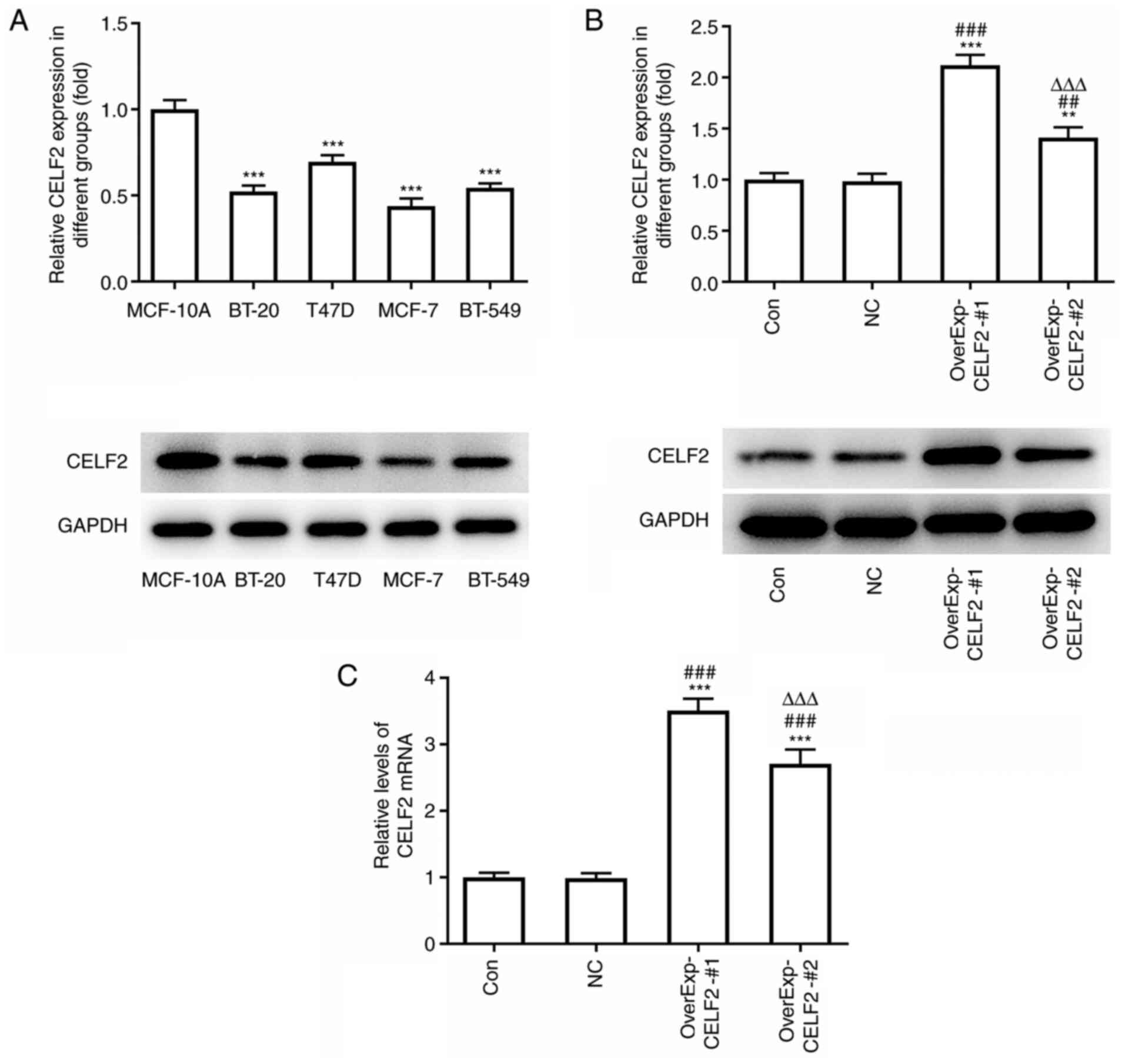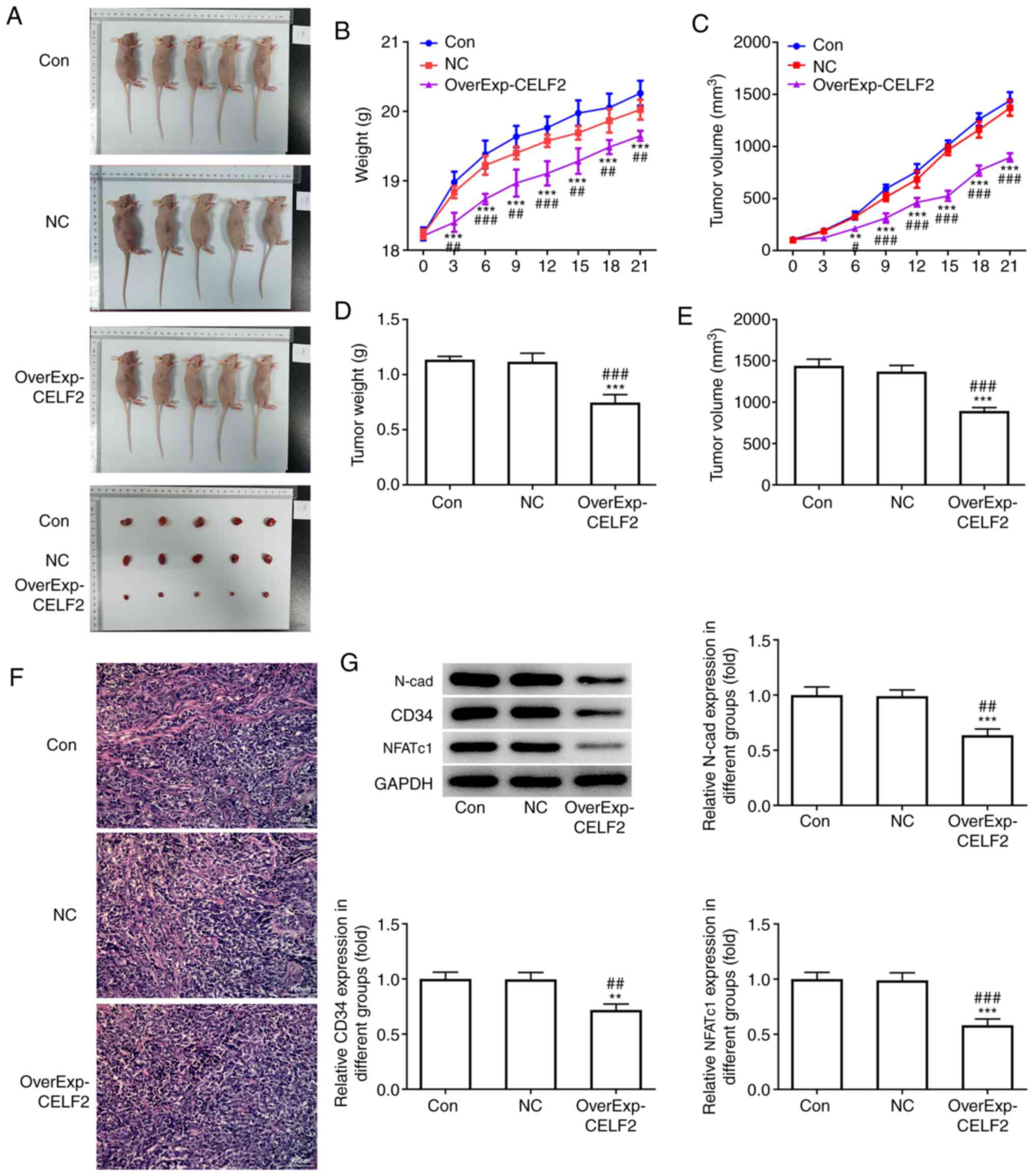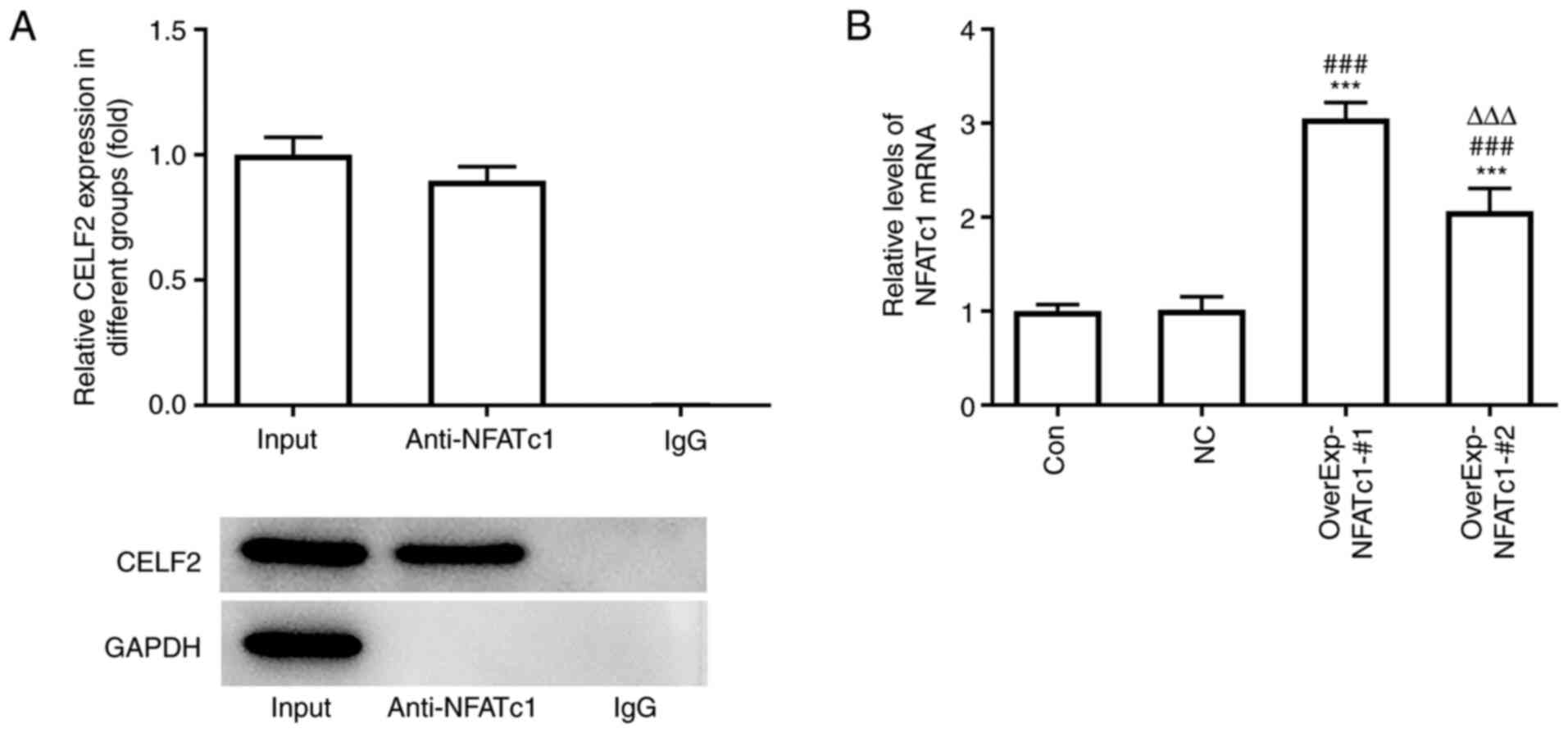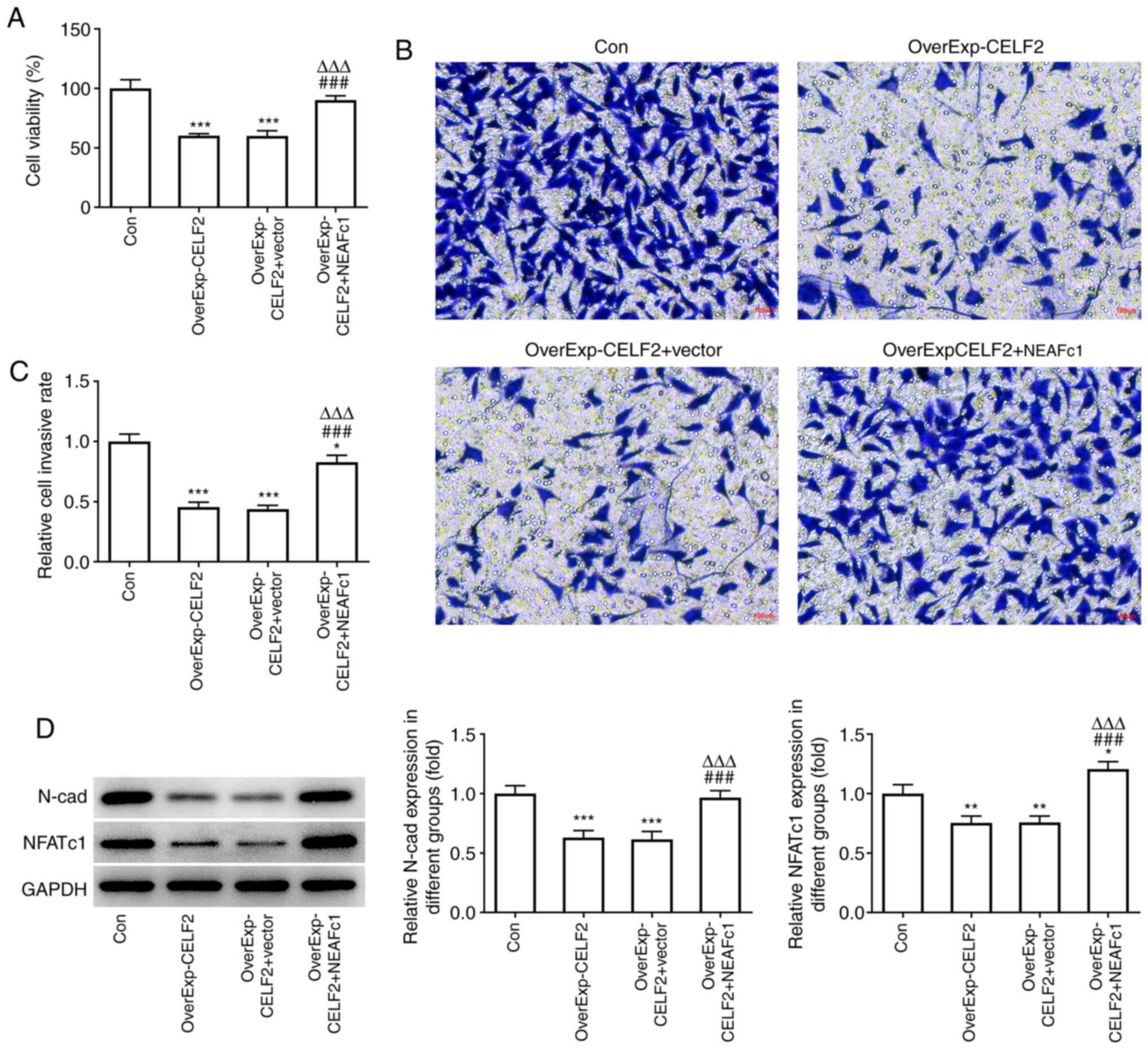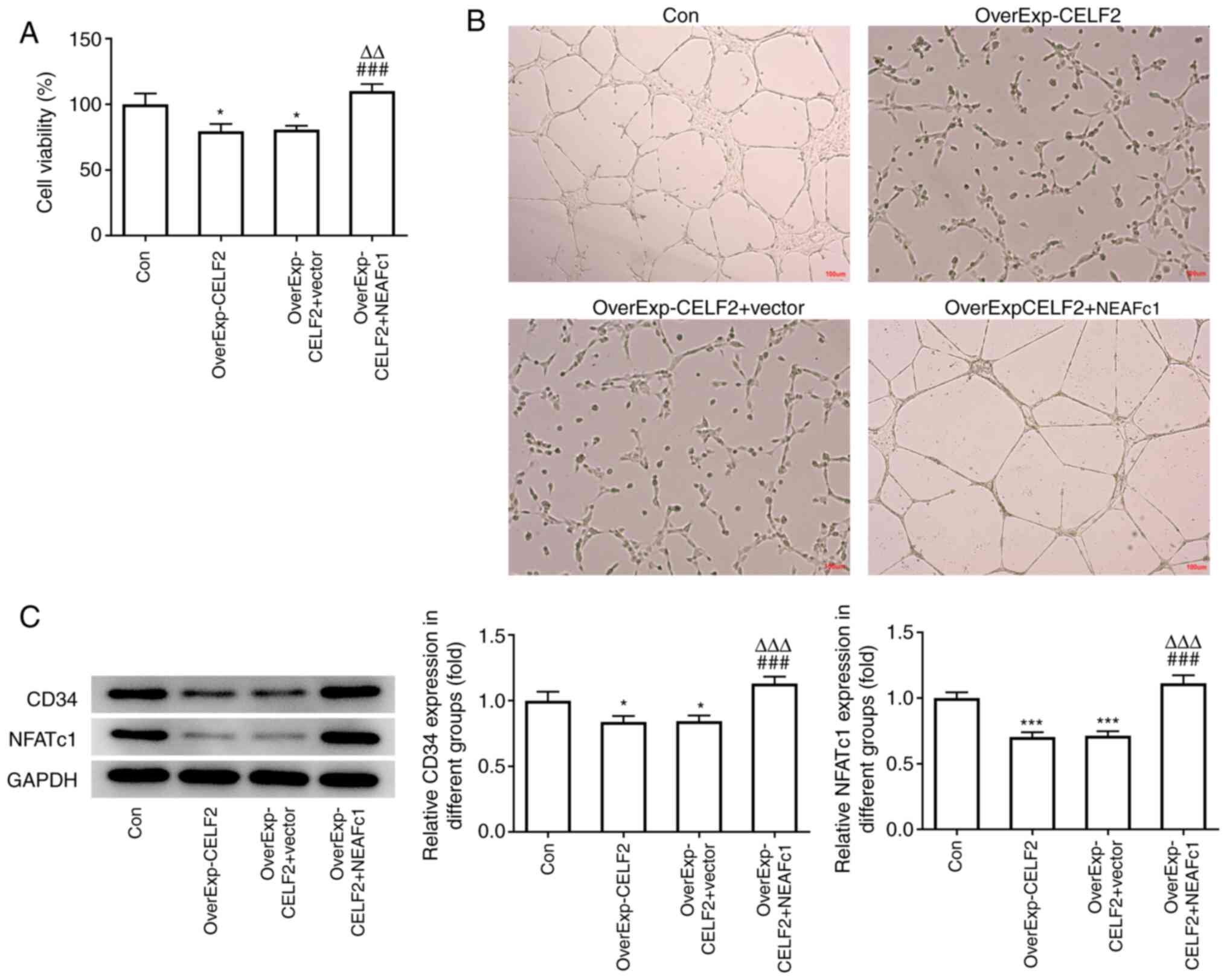|
1
|
Harbeck N and Gnant M: Breast cancer.
Lancet. 389:1134–1150. 2017.PubMed/NCBI View Article : Google Scholar
|
|
2
|
Siegel RL, Miller KD and Jemal A: Cancer
statistics, 2020. CA Cancer J Clin. 70:7–30. 2020.PubMed/NCBI View Article : Google Scholar
|
|
3
|
Chen W, Zheng R, Baade P, Zhang S, Zeng H,
Bray F, Jemal A, Yu X and He J: Cancer statistics in China, 2015.
CA Cancer J Clin. 66:115–132. 2016.PubMed/NCBI View Article : Google Scholar
|
|
4
|
Irnaten M, Zhdanov A, Brennan D, Crotty T,
Clark A, Papkovsky D and O'Brien C: Activation of the NFAT-calcium
signaling pathway in human lamina cribrosa cells in glaucoma.
Invest Ophthalmol Vis Sci. 59:831–842. 2018.PubMed/NCBI View Article : Google Scholar
|
|
5
|
Lu WC, Xie H, Tie XX, Wang R, Wu AH and
Shan FP: NFAT-1 hyper-activation by methionine enkephalin (MENK)
significantly induces cell apoptosis of rats C6 glioma in vivo and
in vitro. Int Immunopharmacol. 56:1–8. 2018.PubMed/NCBI View Article : Google Scholar
|
|
6
|
He RL, Wu ZJ, Liu XR, Gui LX, Wang RX and
Lin MJ: Calcineurin/NFAT signaling modulates pulmonary artery
smooth muscle cell proliferation, migration and apoptosis in
monocrotaline-induced pulmonary arterial hypertension rats. Cell
Physiol Biochem. 49:172–189. 2018.PubMed/NCBI View Article : Google Scholar
|
|
7
|
Müller MR and Rao A: NFAT, immunity and
cancer: A transcription factor comes of age. Nat Rev Immunol.
10:645–656. 2010.PubMed/NCBI View
Article : Google Scholar
|
|
8
|
Ouyang Z, Guo X, Chen X, Liu B, Zhang Q,
Yin Z, Zhai Z, Qu X, Liu X, Peng D, et al: Hypericin targets
osteoclast and prevents breast cancer-induced bone metastasis via
NFATc1 signaling pathway. Oncotarget. 9:1868–1884. 2018.PubMed/NCBI View Article : Google Scholar
|
|
9
|
Liu M, Wei L, Wang Y, Liu P, Liu X and
Zhang M: Effects of NFATc1 on proliferation and apoptosis of breast
cancer cells by regulating RhoA /ROCK signaling pathway. Mod Oncol.
28:562–568. 2020.
|
|
10
|
He Y and Ding M: Research progress on the
interaction between RNA binding proteins and RNA-proteins. Sci
Technol Innovation. 10–13. 2020.
|
|
11
|
Piqué L, Martinez de Paz A, Piñeyro D,
Martínez-Cardús A, Castro de Moura M, Llinàs-Arias P, Setien F,
Gomez-Miragaya J, Gonzalez-Suarez E, Sigurdsson S, et al:
Epigenetic inactivation of the splicing RNA-binding protein CELF2
in human breast cancer. Oncogene. 38:7106–7112. 2019.PubMed/NCBI View Article : Google Scholar
|
|
12
|
Livak KJ and Schmittgen TD: Analysis of
relative gene expression data using real-time quantitative PCR and
the 2(-Delta Delta C(T)) method. Methods. 25:402–408.
2001.PubMed/NCBI View Article : Google Scholar
|
|
13
|
Dou YQ, Kong P, Li CL, Sun HX, Li WW, Yu
Y, Nie L, Zhao LL, Miao SB, Li XK, et al: Smooth muscle SIRT1
reprograms endothelial cells to suppress angiogenesis after
ischemia. Theranostics. 10:1197–1212. 2020.PubMed/NCBI View Article : Google Scholar
|
|
14
|
Jemal A, Bray F, Center M, Ferlay J, Ward
E and Forman D: Global cancer statistics. CA Cancer J Clin.
61:69–90. 2011.PubMed/NCBI View Article : Google Scholar
|
|
15
|
Ferlay J, Soerjomataram I, Dikshit R, Eser
S, Rebelo M, Parkin D, Forman D and Bray F: Cancer incidence and
mortality worldwide: Sources, methods and major patterns in
GLOBOCAN 2012. Int J Cancer. 136:E359–E386. 2014.PubMed/NCBI View Article : Google Scholar
|
|
16
|
Snietura M and Lange D: Current ASCO/CAP
2013 recommendations for testing for HER2 status in breast cancer.
Pol J Pathol. 65 (Suppl 2):S32–S41. 2014.PubMed/NCBI(In Polish).
|
|
17
|
Naja F, Fadel RA, Alameddine M, Aridi Y,
Zarif A, Hariri D, Mugharbel A, Khalil M, Nahleh Z and Tfayli A:
Complementary and alternative medicine use and its association with
quality of life among Lebanese breast cancer patients: A
cross-sectional study. BMC Complement Altern Med.
15(444)2015.PubMed/NCBI View Article : Google Scholar
|
|
18
|
Węsierska-Gądek J and Mauritz M: Why
(multi)targeting of cyclin-dependent kinases is a promising
therapeutic option for hormone-positive breast cancer and beyond.
Future Med Chem. 8:55–72. 2016.PubMed/NCBI View Article : Google Scholar
|
|
19
|
Li D, Bachinski LL and Roberts R: Genomic
organization and isoform-specific tissue expression of human NAPOR
(CUGBP2) as a candidate gene for familial arrhythmogenic right
ventricular dysplasia. Genomics. 74:396–401. 2001.PubMed/NCBI View Article : Google Scholar
|
|
20
|
Ramalingam S, Ramamoorthy P, Subramaniam D
and Anant S: Reduced expression of RNA binding protein CELF2, a
putative tumor suppressor gene in colon cancer.
Immunogastroenterology. 1:27–33. 2012.PubMed/NCBI View
Article : Google Scholar
|
|
21
|
Wang J, Liu L, Sun Y, Xue Y, Qu J, Pan S,
Li H, Qu H, Wang J and Zhang J: miR-615-3p promotes proliferation
and migration and inhibits apoptosis through its potential target
CELF2 in gastric cancer. Biomed Pharmacother. 101:406–413.
2018.PubMed/NCBI View Article : Google Scholar
|
|
22
|
Yeung YT, Fan S, Lu B, Yin S, Yang S, Nie
W, Wang M, Zhou L, Li T, Li X, et al: CELF2 suppresses non-small
cell lung carcinoma growth by inhibiting the PREX2-PTEN
interaction. Carcinogenesis. 41:377–389. 2020.PubMed/NCBI View Article : Google Scholar
|
|
23
|
Xu W, Gu J, Ren Q, Shi Y, Xia Q and Wang
J, Wang S, Wang Y and Wang J: NFATC1 promotes cell growth and
tumorigenesis in ovarian cancer up-regulating c-Myc through
ERK1/2/p38 MAPK signal pathway. Tumour Biol. 37:4493–4500.
2016.PubMed/NCBI View Article : Google Scholar
|
|
24
|
Wang L, Wang Z, Li J, Zhang W, Ren F and
Yue W: NFATc1 activation promotes the invasion of U251 human
glioblastoma multiforme cells through COX-2. Int J Mol Med.
35:1333–1340. 2015.PubMed/NCBI View Article : Google Scholar
|
|
25
|
Liu Y, Liang T, Qiu X, Ye X, Li Z, Tian B
and Yan D: Down-regulation of Nfatc1 suppresses proliferation,
migration, invasion, and warburg effect in prostate cancer cells.
Med Sci Monit. 25:1572–1581. 2019.PubMed/NCBI View Article : Google Scholar
|
|
26
|
Li L, Duan Z, Yu J and Dang HX: NFATc1
regulates cell proliferation, migration, and invasion of ovarian
cancer SKOV3 cells in vitro and in vivo. Oncol Rep. 36:918–928.
2016.PubMed/NCBI View Article : Google Scholar
|















